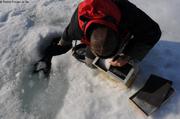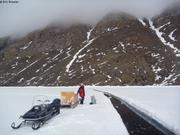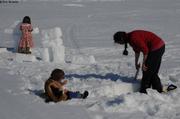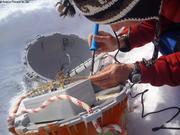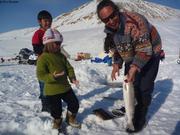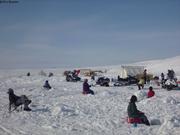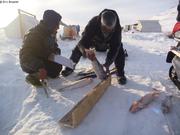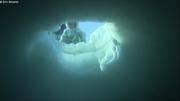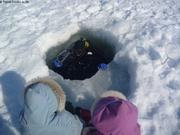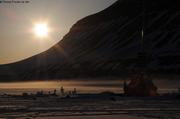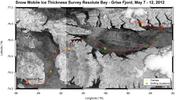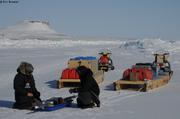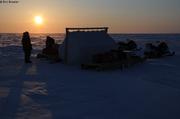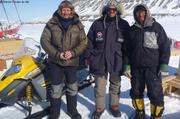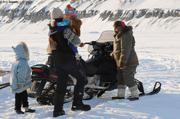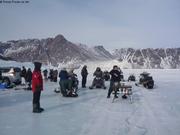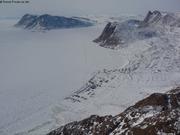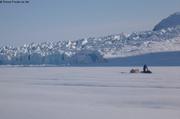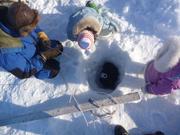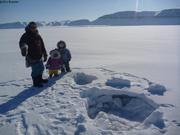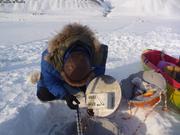By France Pinczon du Sel.
Eric is the king to keep surprises. At lunch time for my birthday, Liza's
arrival is unexpected... for me. And in addition to the seal skin and the wolf
fur she gives me as a present, she is offering me the best: sharing her
hunting experience during the afternoon! So we leave both of us looking for
seals, who now are more and more laying down on the ice. Several times we stop
at some reasonable distance, Liza supports her rifle on the windscreen of the
skidoo, aims and shoots. Seals can be as far as 300m. Sometimes the seal dives
too quickly in his hole. Once, she succeeds. But the animal, wounded, slides
in his hole. So we come very close and wait for the animal to appear again; he
needs to breeze. Liza is ready to shoot, and me to pick it up. Five minutes
later I can hear blowing and breezing, more and more loudly, through the
bloody slush. Then the seal's nose appears. Liza picks then shoot, we loose
it, I pick again. Then while Liza is looking for the tuk to secure and put the
catch out of the water, I try to hoist it but the skin tears again and this
time, the seal sinks! I'm learning by making mistakes... A seal is too heavy
to be hoist on the ice with a simple hook. Later on, we wait at a breezing
hole. I learn the distance, the shooting position, not to be seen but to be
able to shoot enough vertically. And above all, patience and silence. Liza can
sea from really far any kind of life on the sea ice. I feel her pleasure and
experience... She is hunting since she is 5 years old! Soon, I hope, I will
use what I learned with her this day. Even more since this special day brings
me the dreamed tool: the ulu, the Inuit women's knife, used to process the
seals skins, also to eat the meat. Aksakjuk, Liza's husband, needed three days
to make it. So it's Eric's present, in complicity with our best friends in
Grise Fiord. The very nice Léonie's draws with so beautiful parcels also
marked my 42 years birthday!
Then comes the weed end, at the village. Eric flies with Tom to Resolute, for
some measurements on sea ice all the way to Vagabond. They are joining
Christian Haas, for who we are working since last summer. After he left, we
flew over Vagabond with the film crew, with some Inuit friends. Aurore slept
from the beginning but Léonie could admire with us the magic land, colours of
the evening, and notice how our four dogs where surprised to see the plane
turning so many times around them!
On Sunday, I could join by skidoo a group of people going for a trip to the
top of the mountain over Grise Fiord, passing by the glacier behind. Some of
them drive with their skidoos on some very vertical tops to run high speed
down... Scary! Good and nice escapade... without the children! By 4pm,
attaching again the qamutik to my skidoo, I was glad to bring a happy little
group of kids to the picnic, at the end of the "ice road". Families are used
to fix out nicely and so fast everything they need: stoves, food, snow to
melt, frozen seal to eat on ice, pieces of caribou... Everyone is cooking,
nice atmosphere, little bit strange on the slippery ice... we are sliding as
much as walking. Kids are sliding, playing hockey... Then suddenly food is
ready, everybody join around, pray and bless the food, leaded by Aksakjuk.
Then, we have the delicious meal. Coming back at 8pm, with all these children,
happy in the qamutik.
Aksakjuk told us about his past in Grise Fiord. His history, as well as
Liza's, since they are kids, are strong and impressive. They gave to us a new
light about all what we could hear about the amazing story of Grise Fiord
inuit "relocation".
